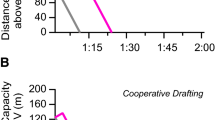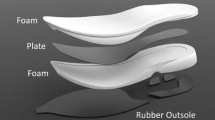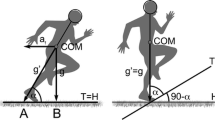Abstract
A sub-2-hour marathon requires an average velocity (5.86 m/s) that is 2.5% faster than the current world record of 02:02:57 (5.72 m/s) and could be accomplished with a 2.7% reduction in the metabolic cost of running. Although supporting body weight comprises the majority of the metabolic cost of running, targeting the costs of forward propulsion and leg swing are the most promising strategies for reducing the metabolic cost of running and thus improving marathon running performance. Here, we calculate how much time could be saved by taking advantage of unconventional drafting strategies, a consistent tailwind, a downhill course, and specific running shoe design features while staying within the current International Association of Athletic Federations regulations for record purposes. Specifically, running in shoes that are 100 g lighter along with second-half scenarios of four runners alternately leading and drafting, or a tailwind of 6.0 m/s, combined with a 42-m elevation drop could result in a time well below the 2-hour marathon barrier.









Similar content being viewed by others
Notes
Examples include 5000-m runner Harald Norpoth and cyclist Michael Rasmussen.
For sprinting events on the track, the maximum IAAF allowable wind velocity for record purposes is only 2.0 m/s (IAAF rule 260.14c [54]).
Read more on the 2011 Boston Marathon here: http://www.espn.com/boston/news/story?id=6381520.
References
Joyner MJ, Ruiz JR, Lucia A. The two-hour marathon: who and when? J Appl Physiol. 2011;110:275–7.
Weiss M, Newman A, Whitmore C, et al. One hundred and fifty years of sprint and distance running—past trends and future prospects. Eur J Sport Sci. 2016;16:393–401.
Hill AV. The physiological basis of athletic records. Lancet. 1925;206:481–6.
Kennelly AE. An approximate law of fatigue in the speeds of racing animals. Proc Am Acad Arts Sci. 1906;42:275.
Liu Y, Schutz RW. Prediction models for track and field performances. Meas Phys Educ Exerc Sci. 1998;2:205–23.
Caesar E. Two hours: the quest to run the impossible marathon. New York: Simon & Schuster; 2015.
Tucker R, Santos-Concejero J. An imminent sub 2-hours marathon is unlikely: historical trends of the gender gap in running events. Int J Sports Physiol Perform. Epub 14 December 2016.
Hutchinson A. What will it take to run a 2-hour marathon. Runner’s world. http://rw.runnersworld.com/sub-2.
Nike introduces breaking2: the quest to break the two-hour marathon barrier. Nike News; 2016 December 12. http://news.nike.com/news/2-hour-marathon.
Germano S. Adidas, like Nike, is working on sub-2 hour marathon project. Wall Street J. 2016 Dec 16. https://www.wsj.com/articles/adidas-like-nike-is-working-on-sub-2-hour-marathon-project-1481886001.
Sub2. Countdown to the first sub2hr marathon: no longer a matter of if but rather when. http://www.sub2hrs.com/.
Péronnet F, Thibault G. Mathematical analysis of running performance and world running records. J Appl Physiol. 1989;67:453–65.
Joyner MJ. Modeling: optimal marathon performance on the basis of physiological factors. J Appl Physiol. 1991;70:683–7.
Joyner MJ, Coyle EF. Endurance exercise performance: the physiology of champions. J Physiol. 2008;586:35–44.
Shaw AJ, Ingham SA, Atkinson G, et al. The correlation between running economy and maximal oxygen uptake: cross-sectional and longitudinal relationships in highly trained distance runners. PLoS One. 2015;10:e0123101.
Bassett DR, Howley ET. Limiting factors for maximum oxygen uptake and determinants of endurance performance. Med Sci Sports Exerc. 2000;32:70–84.
Coyle EF. Integration of the physiological factors determining endurance performance ability. Exerc Sport Sci Rev. 1995;23:25–63.
Williams KR, Cavanagh PR. Relationship between distance running mechanics, running economy, and performance. J Appl Physiol. 1987;63:1236–45.
Fuller JT, Bellenger CR, Thewlis D, et al. The effect of footwear on running performance and running economy in distance runners. Sports Med. 2015;45:411–22.
Hoogkamer W, Kipp S, Spiering BA, et al. Altered running economy directly translates to altered distance-running performance. Med Sci Sports Exerc. 2016;48:2175–80.
El Helou N, Tafflet M, Berthelot G, et al. Impact of environmental parameters on marathon running performance. PLoS One. 2012;7:e37407.
Di Prampero PE, Atchou G, Brückner JC, et al. The energetics of endurance running. Eur J Appl Physiol Occup Physiol. 1986;55:259–66.
Smith CGM, Jones AM. The relationship between critical velocity, maximal lactate steady-state velocity and lactate turnpoint velocity in runners. Eur J Appl Physiol. 2001;85:19–26.
Poole DC, Burnley M, Vanhatalo A, et al. Critical power: an important fatigue threshold in exercise physiology. Med Sci Sports Exerc. 2016;48:2320–34.
Frederick EC, Daniels JT, Hayes JW. The effect of shoe weight on the aerobic demands of running. In: Bachl N, Prokop L, Suckert R, editors. Curr Top Sports Med Proc World Congr Sports Med. Vienna: Urban and Schwarzenberg; 1984. p. 616–25.
Franz JR, Wierzbinski CM, Kram R. Metabolic cost of running barefoot versus shod. Med Sci Sports Exerc. 2012;44:1519–25.
Pugh LG. Oxygen intake in track and treadmill running with observations on the effect of air resistance. J Physiol. 1970;207:823–35.
Steudel-Numbers KL, Wall-Scheffler CM. Optimal running speed and the evolution of hominin hunting strategies. J Hum Evol. 2009;56:355–60.
Daniels J, Krahenbuhl G, Foster C, et al. Aerobic responses of female distance runners to submaximal and maximal exercise. Ann NY Acad Sci. 1977;301:726–33.
Daniels JT. A physiologist’s view of running economy. Med Sci Sports Exerc. 1985;17:332–8.
Batliner M. Does VO2 increase linearly with speed in average and sub-elite distance runners?. Boulder: University of Colorado; 2013.
Margaria R, Cerretelli P, Aghemo P, et al. Energy cost of running. J Appl Physiol. 1963;18:367–70.
Léger L, Mercier D. Gross energy cost of horizontal treadmill and track running. Sports Med. 1984;1:270–7.
Jones AM, Doust JH. A 1% treadmill grade most accurately reflects the energetic cost of outdoor running. J Sports Sci. 1996;14:321–7.
Kyle CR, Caiozzo VJ. The effect of athletic clothing aerodynamics upon running speed. Med Sci Sports Exerc. 1986;18:509–15.
McMiken DF, Daniels JT. Aerobic requirements and maximum aerobic power in treadmill and track running. Med Sci Sports Exerc. 1976;8:14–7.
Tam E, Rossi H, Moia C, et al. Energetics of running in top-level marathon runners from Kenya. Eur J Appl Physiol. 2012;112:3797–806.
Pugh LG. The influence of wind resistance in running and walking and the mechanical efficiency of work against horizontal or vertical forces. J Physiol. 1971;213:255–76.
Di Prampero P. The energy cost of human locomotion on land and in water. Int J Sports Med. 1986;07:55–72.
Pollock ML. Submaximal and maximal working capacity of elite distance runners. Part I: cardiorespiratory aspects. Ann NY Acad Sci. 1977;301:310–22.
Larsen HB. Kenyan dominance in distance running. Comp Biochem Physiol A Mol Integr Physiol. 2003;136:161–70.
Daniels JT, Gilbert J. Oxygen power: performance tables for distance runners. Tempe, AZ: Daniels and Gilbert; 1979.
Brueckner JC, Atchou G, Capelli C, et al. The energy cost of running increases with the distance covered. Eur J Appl Physiol Occup Physiol. 1991;62:385–9.
Nicol C, Komi PV, Marconnet P. Effects of marathon fatigue on running kinematics and economy. Scand J Med Sci Sports. 1991;1:195–204.
Kyröläinen H, Pullinen T, Candau R, et al. Effects of marathon running on running economy and kinematics. Eur J Appl Physiol. 2000;82:297–304.
Lacour JR, Bourdin M. Factors affecting the energy cost of level running at submaximal speed. Eur J Appl Physiol. 2015;115:651–73.
Arellano CJ, Kram R. Partitioning the metabolic cost of human running: a task-by-task approach. Integr Comp Biol. 2014;54:1084–98.
Kram R, Taylor CR. Energetics of running: a new perspective. Nature. 1990;346:265–7.
Teunissen LPJ, Grabowski A, Kram R. Effects of independently altering body weight and body mass on the metabolic cost of running. J Exp Biol. 2007;210:4418–27.
Aaron EA, Johnson BD, Seow CK, et al. Oxygen cost of exercise hyperpnea: measurement. J Appl Physiol. 1992;72:1810–7.
Aaron EA, Seow KC, Johnson BD, et al. Oxygen cost of exercise hyperpnea: implications for performance. J Appl Physiol. 1992;72:1818–25.
Farley CT, McMahon TA. Energetics of walking and running: insights from simulated reduced-gravity experiments. J Appl Physiol. 1992;73:2709–12.
Judelson DA, Maresh CM, Anderson JM, et al. Hydration and muscular performance: does fluid balance affect strength, power and high-intensity endurance? Sports Med. 2007;37:907–21.
Coyle EF, González-Alonso J. Cardiovascular drift during prolonged exercise: new perspectives. Exerc Sport Sci Rev. 2001;29:88–92.
Armstrong LE, Whittlesey MJ, Casa DJ, et al. No effect of 5% hypohydration on running economy of competitive runners at 23 degrees C. Med Sci Sports Exerc. 2006;38:1762–9.
Beis LY, Wright-Whyte M, Fudge B, et al. Drinking behaviors of elite male runners during marathon competition. Clin J Sports Med. 2012;22:254–61.
Pavei G, Biancardi CM, Minetti AE. Skipping vs. running as the bipedal gait of choice in hypogravity. J Appl Physiol. 2015;119:93–100.
Kerdok AE, Biewener AA, McMahon TA, et al. Energetics and mechanics of human running on surfaces of different stiffnesses. J Appl Physiol. 2002;92:469–78.
Tung KD, Franz JR, Kram R. A test of the metabolic cost of cushioning hypothesis during unshod and shod running. Med Sci Sports Exerc. 2014;46:324–9.
International Association of Athletics Federations. Competition rules 2016–2017. Monaco: International Association of Athletics Federations; 2015.
Chang YH, Kram R. Metabolic cost of generating horizontal forces during human running. J Appl Physiol. 1999;86:1657–62.
Vernillo G, Schena F, Berardelli C, et al. Anthropometric characteristics of top-class Kenyan marathon runners. J Sports Med Phys Fitness. 2013;53:403–8.
Brisswalter J, Hausswirth C. Consequences of drafting on human locomotion: benefits on sports performance. Int J Sports Physiol Perform. 2008;3:3–15.
International Association of Athletics Federations. Records and lists: top lists. Senior outdoor half marathon men. https://www.iaaf.org/records/toplists/road-running/half-marathon/outdoor/men/senior.
Kyle CR. Reduction of wind resistance and power output of racing cyclists and runners traveling in groups. Ergonomics. 1979;22:387–97.
Davies CT. Effects of wind assistance and resistance on the forward motion of a runner. J Appl Physiol. 1980;48:702–9.
Snyder KL, Farley CT. Energetically optimal stride frequency in running: the effects of incline and decline. J Exp Biol. 2011;214:2089–95.
Minetti AE, Ardigò LP, Saibene F. Mechanical determinants of the minimum energy cost of gradient running in humans. J Exp Biol. 1994;195:211–25.
Minetti AE, Moia C, Roi GS, et al. Energy cost of walking and running at extreme uphill and downhill slopes. J Appl Physiol. 2002;93:1039–46.
Myers MJ, Steudel K. Effect of limb mass and its distribution on the energetic cost of running. J Exp Biol. 1985;116:363–73.
Martin PE. Mechanical and physiological responses to lower extremity loading during running. Med Sci Sports Exerc. 1985;17:427–33.
Saltin B, Larsen H, Terrados N, et al. Aerobic exercise capacity at sea level and at altitude in Kenyan boys, junior and senior runners compared with Scandinavian runners. Scand J Med Sci Sports. 1995;5:209–21.
Brüggemann G-P, Arampatzis A, Emrich F, et al. Biomechanics of double transtibial amputee sprinting using dedicated sprinting prostheses. Sports Technol. 2009;1:220–7.
Weyand PG, Bundle MW, McGowan CP, et al. The fastest runner on artificial legs: different limbs, similar function? J Appl Physiol. 2009;107:903–11.
Beck ON, Taboga P, Grabowski AM. Reduced prosthetic stiffness lowers the metabolic cost of running for athletes with bilateral transtibial amputations. J Appl Physiol. 2017. doi:10.1152/japplphysiol.00587.2016.
Frederick EC, Clarke TE, Larsen JL, et al. The effects of shoe cushioning on the oxygen demands of running. In: Nigg BM, Kerr BA, editors. Biomechanical aspects of sports shoes and playing surfaces. Calgary: The University of Calgary; 1983. p. 107–14.
Worobets J, Wannop JW, Tomaras E, et al. Softer and more resilient running shoe cushioning properties enhance running economy. Footwear Sci. 2014;6:147–53.
Frederick EC, Howley ET, Powers SK. Lower O2 cost while running on air cushion type shoe. Med Sci Sports Exerc. 1980;12:81–2.
Roy J-PR, Stefanyshyn DJ. Shoe midsole longitudinal bending stiffness and running economy, joint energy, and EMG. Med Sci Sports Exerc. 2006;38:562–9.
Madden R, Sakaguchi M, Wannop J, et al. Forefoot bending stiffness, running economy and kinematics during overground running. Footwear Sci. 2015;7:S11–3.
Acknowledgements
The authors thank Owen Beck, Len Brownlie, Dan Judelson, and Geng Luo for fruitful discussions, Elissa Johnson for illustrations, and Sean Hartnett for the Berlin 2014 split time data.
Author information
Authors and Affiliations
Corresponding author
Ethics declarations
Funding
No sources of funding were used to assist in the preparation of this article.
Conflict of interest
Wouter Hoogkamer and Christopher Arellano have no conflicts of interest relevant to the content of this review. Rodger Kram is a paid consultant to Nike, Inc., which is engaged in a sub-2-hour marathon project. The views expressed in this manuscript do not represent those of Nike, Inc.
Electronic supplementary material
Below is the link to the electronic supplementary material.
Rights and permissions
About this article
Cite this article
Hoogkamer, W., Kram, R. & Arellano, C.J. How Biomechanical Improvements in Running Economy Could Break the 2-hour Marathon Barrier. Sports Med 47, 1739–1750 (2017). https://doi.org/10.1007/s40279-017-0708-0
Published:
Issue Date:
DOI: https://doi.org/10.1007/s40279-017-0708-0




